 "QUANTUM SHOT" #656 "QUANTUM SHOT" #656
Link
- article by M. Christian and
A. Abrams
Beautiful Typewriters From 'The Good Old Days'
Horse and buggies, hoop skirts, steam engines, bustles ... oh, yes, life
around the turn of the previous century was a delight of simplicity and
workmanship. But that doesn't mean that the artisans and engineers of
way-back-when didn’t at least have their hearts and minds in the right
place.
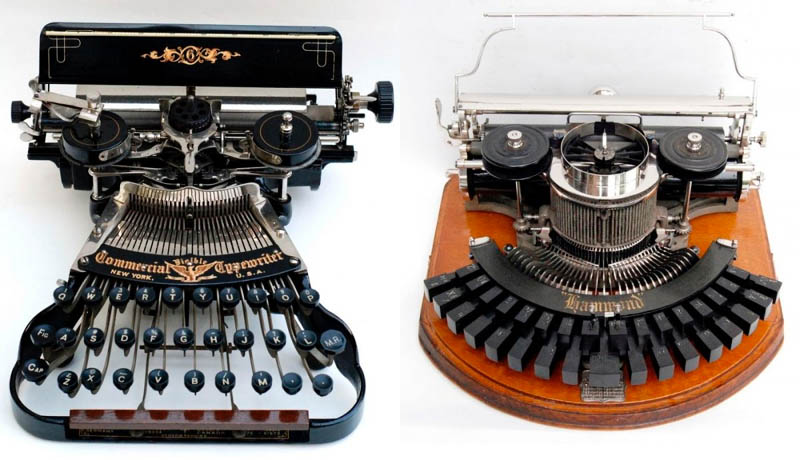 (images via
The Typewriter Museum)
Take, for example, what writing used to be like before a few very bright
bulbs thought to create machines to make it easier: pens that constantly
ran dry, ink that spilled or smeared, illegible handwriting ... getting
the message across -- any message across -- by hand was problematic at
best, totally confusing at worst.
Linear Index Typewriters and "Typewritors"
One of the earliest of those bright bulbs was William Austin Burt who, in
1829, created what he called a 'typewritor.' If Burt's machine was, in
fact, the first is a matter of much debate - as another, similar, machine
had also been built by Pellegrino Turri around the same time. Some even
say the crown of 'first' should go to Henry Mill, who created a writing
machine way back in 1714.
(images via
The Typewriter Museum)
Take, for example, what writing used to be like before a few very bright
bulbs thought to create machines to make it easier: pens that constantly
ran dry, ink that spilled or smeared, illegible handwriting ... getting
the message across -- any message across -- by hand was problematic at
best, totally confusing at worst.
Linear Index Typewriters and "Typewritors"
One of the earliest of those bright bulbs was William Austin Burt who, in
1829, created what he called a 'typewritor.' If Burt's machine was, in
fact, the first is a matter of much debate - as another, similar, machine
had also been built by Pellegrino Turri around the same time. Some even
say the crown of 'first' should go to Henry Mill, who created a writing
machine way back in 1714.
All of these devices represented just baby steps: more potential than
actual ability to help with clear, concise and fast writing. There were a
lot of others after these early pioneers, but none of them were ever a
real commercial success. Looking at them you can see why: in many of these
very early models – called 'index typewriters,' by the way – the
typing was done by selecting the letter to be used on a slider and then
pressing it against the paper. To call these early monsters 'slow' is
being kind. Changing the alphabetical slider to a disc version helped a
bit but not enough to make any of these machines easy or popular.
Here is a "Linear Typewriter": one look at this machine and you can see
why it was never a big hit. Just think about transcribing anything on this
beast:
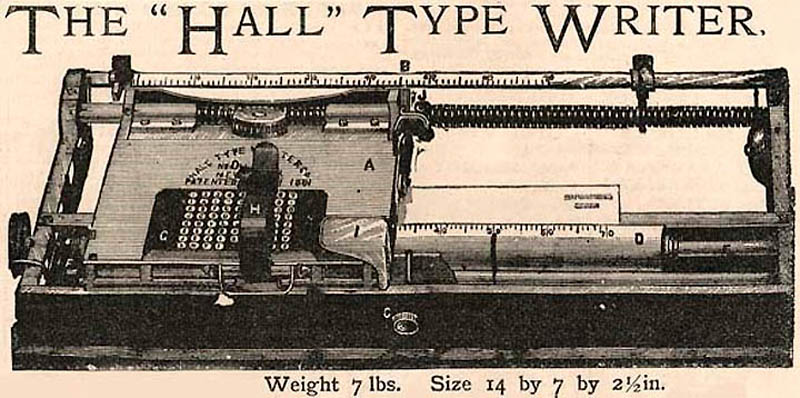 (images via
Office Museum)
The 1890 Victor: "Take a letter, Miss Jones."
(images via
Office Museum)
The 1890 Victor: "Take a letter, Miss Jones."
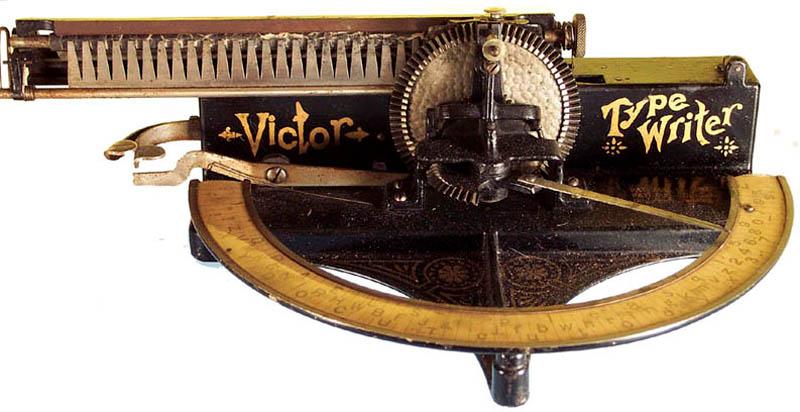 (images via
Office Museum)
The Writing Ball That Will Warp and Enchant Your Mind
In 1865 what many consider to be the true ancestor to true, efficient, and
financially successful typewriter was developed by Rasmus Malling-Hansen:
The Writing Ball. Not only was it efficient, but also strangely
elegant, even beautiful: just look at it - a brass half-sphere covered
with keys above a cylinder that held the paper. It was finely made, unlike
some of the unsuccessful machines before, looking more like a gentleman's
watch than a piece of office equipment:
(images via
Office Museum)
The Writing Ball That Will Warp and Enchant Your Mind
In 1865 what many consider to be the true ancestor to true, efficient, and
financially successful typewriter was developed by Rasmus Malling-Hansen:
The Writing Ball. Not only was it efficient, but also strangely
elegant, even beautiful: just look at it - a brass half-sphere covered
with keys above a cylinder that held the paper. It was finely made, unlike
some of the unsuccessful machines before, looking more like a gentleman's
watch than a piece of office equipment:
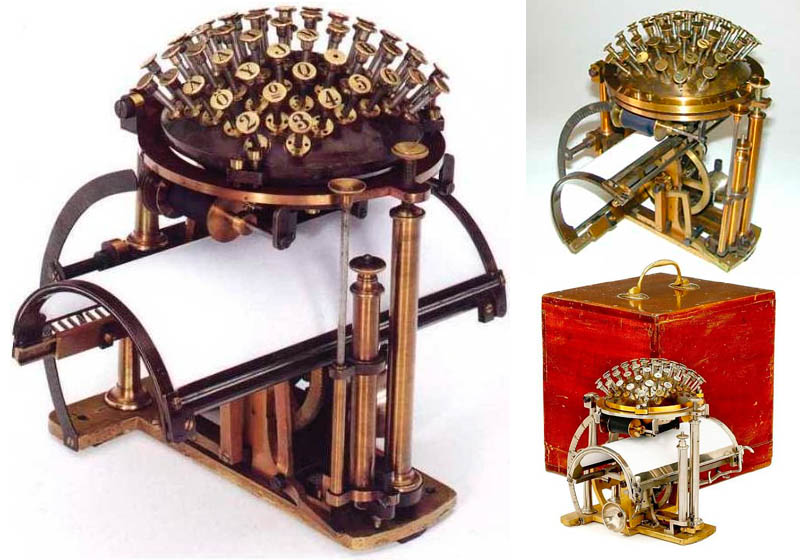 (image credit: Auction Team Koln,
via)
The Malling-Hansen Writing Ball: not only one of the first commercial
typewriters but also one of the most elegant (more pics and auction price
info):
(image credit: Auction Team Koln,
via)
The Malling-Hansen Writing Ball: not only one of the first commercial
typewriters but also one of the most elegant (more pics and auction price
info):
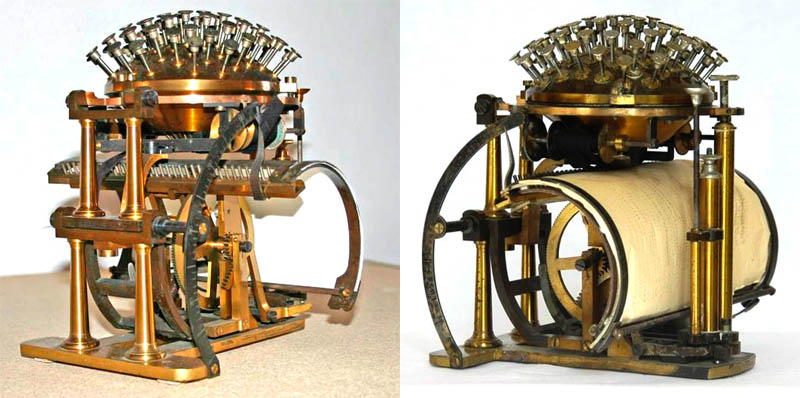 (images credit:
Auction Team Koln, via
The Malling-Hansen Society)
The Beauty of the Ball - It may have been difficult to use but it sure
looked good on your desk:
(images credit:
Auction Team Koln, via
The Malling-Hansen Society)
The Beauty of the Ball - It may have been difficult to use but it sure
looked good on your desk:
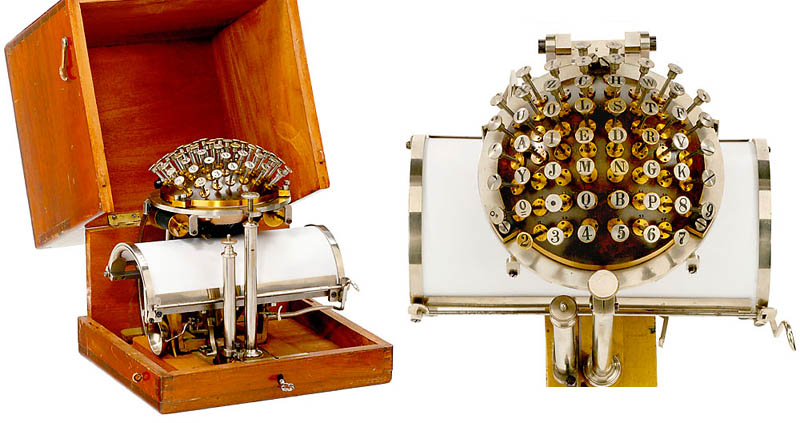 (image credit: Auction Team Koln,
via)
An Illustration of the Malling-Hansen Writing Ball: a lovely etching of
the typewriter ball by Hans Gerhard Blodorn - buy a copy
here
(image credit: Auction Team Koln,
via)
An Illustration of the Malling-Hansen Writing Ball: a lovely etching of
the typewriter ball by Hans Gerhard Blodorn - buy a copy
here
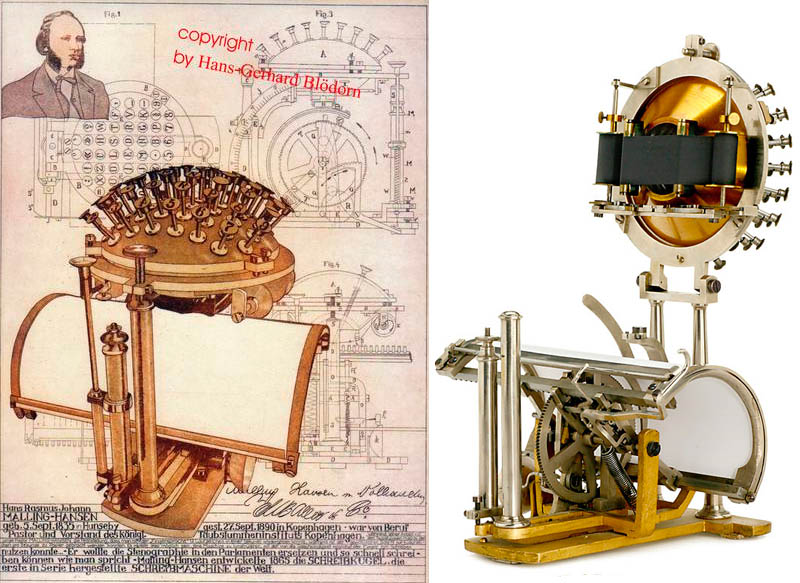 (image credit:
Hans Gerhard Blodorn)
More pretty pictures of Hansen's lovely creation at
The Typewriter Museum:
(image credit:
Hans Gerhard Blodorn)
More pretty pictures of Hansen's lovely creation at
The Typewriter Museum:
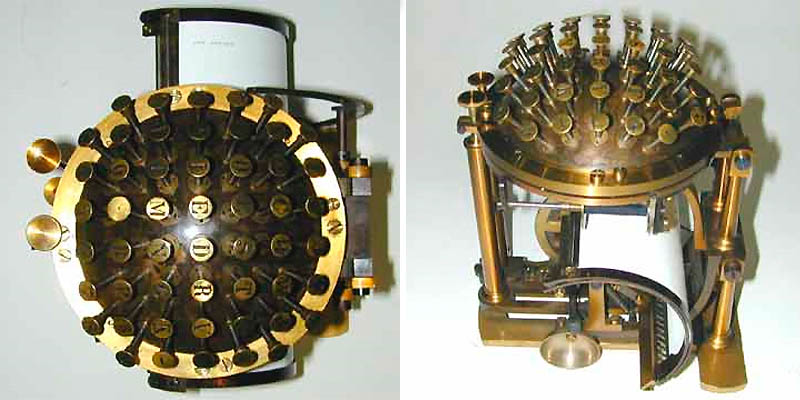 (images credit:
The Typewriter Museum)
Sure, Hansen's Ball had some rather serious flaws – like the fact that it
was hardly cheap and, because of the position of the ball and the paper
under it, the typist really couldn't see what they were typing until they
were done and the paper was removed from the machine -- but that didn't
stop it from selling better than many other previous models. One quirk of
the ball was that, unlike the QWERTY keyboard that pretty much every
typewriter after it had and every computer now has, the ball's keys had
been positioned to make typing easier for the typist and not the
typewriter.
The Sad, Strange Story of QWERTY
By the way, in case you don't know the sad, strange story of QWERTY –
which haunts us to this day -- the alphabet were originally put in that
order because otherwise users would type faster than the machine could
handle, thus jamming the keys. So QWERTY was created to keep that from
happening: to keep the machine happy at the cost of typist efficiency.
(images credit:
The Typewriter Museum)
Sure, Hansen's Ball had some rather serious flaws – like the fact that it
was hardly cheap and, because of the position of the ball and the paper
under it, the typist really couldn't see what they were typing until they
were done and the paper was removed from the machine -- but that didn't
stop it from selling better than many other previous models. One quirk of
the ball was that, unlike the QWERTY keyboard that pretty much every
typewriter after it had and every computer now has, the ball's keys had
been positioned to make typing easier for the typist and not the
typewriter.
The Sad, Strange Story of QWERTY
By the way, in case you don't know the sad, strange story of QWERTY –
which haunts us to this day -- the alphabet were originally put in that
order because otherwise users would type faster than the machine could
handle, thus jamming the keys. So QWERTY was created to keep that from
happening: to keep the machine happy at the cost of typist efficiency.
Here's a fun bit of trivia for you folks now interested in
Malling-Hansen's elegant writing ball: one particular person was
interested in this new, wondrous invention – a celebrated writer who was
having a hard time with his diminishing eyesight. While
Nietzsche did get and use his writing ball he sadly didn't love it
– though it is fascinating to visualize the author of Thus Spoke
Zarathustra clicking and clacking on the mechanical beauty of one of
Hansen's creations.
 Balls Of Every Shape And Size
Hansen didn't stop with his first creation. Over the years after the
release of his first ball he created a whole range of machines with all
kinds of variations: A handsome selection of Malling-Hansen Writing Balls,
including a lovely one in a wooden case can be found at
The Malling-Hansen Society
-
Balls Of Every Shape And Size
Hansen didn't stop with his first creation. Over the years after the
release of his first ball he created a whole range of machines with all
kinds of variations: A handsome selection of Malling-Hansen Writing Balls,
including a lovely one in a wooden case can be found at
The Malling-Hansen Society
-
 The Miniature Writing Ball (more info and pictures
here):
The Miniature Writing Ball (more info and pictures
here):
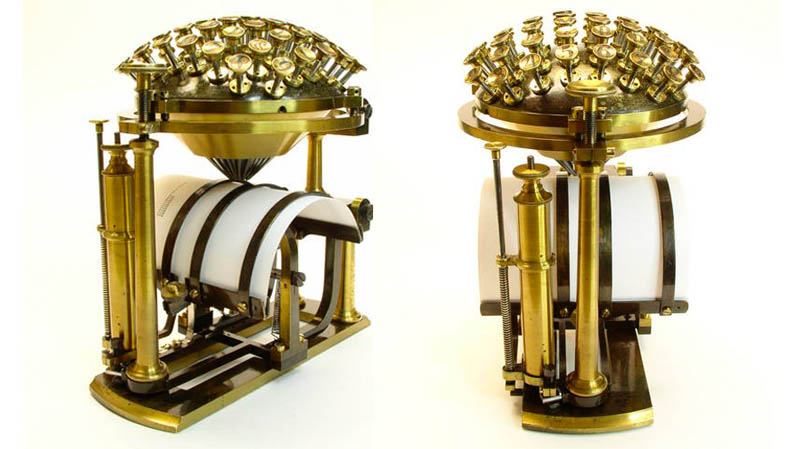 (images
via)
The cryptographic writing ball by Alexis Kohls, circa 1883 -
(images
via)
The cryptographic writing ball by Alexis Kohls, circa 1883 -
 Another fascinating keyboard variation: The Piano-style Keyboard -
American-made Hammond from 1880:
Another fascinating keyboard variation: The Piano-style Keyboard -
American-made Hammond from 1880:
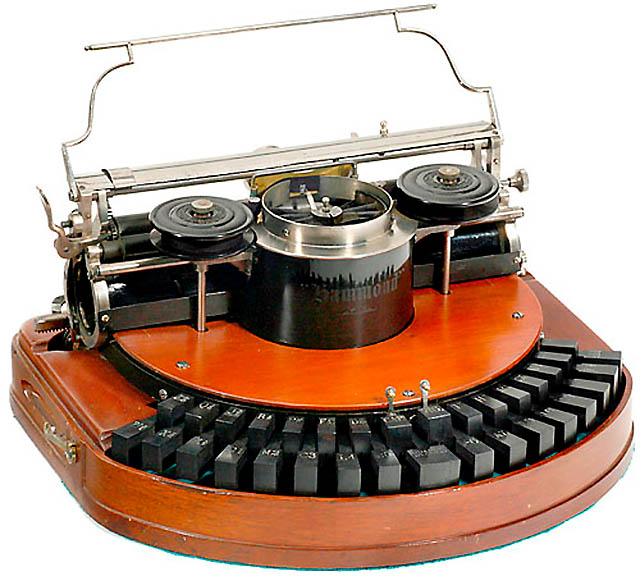 (image
via)
Eventually, though, other – and cheaper – machines were developed, saving
generations of writers, secretaries, business people, and anyone else who
used to have to put pen to paper, from cramp and bad handwriting. Though
Hansen and his elegant ball have been almost lost to time it's nice to be
able to show a new, QWERTY-slaved generation, the beauty of his creation.
CONTINUE TO "CURTA MECHANICAL CALCULATORS"! ->
(image
via)
Eventually, though, other – and cheaper – machines were developed, saving
generations of writers, secretaries, business people, and anyone else who
used to have to put pen to paper, from cramp and bad handwriting. Though
Hansen and his elegant ball have been almost lost to time it's nice to be
able to show a new, QWERTY-slaved generation, the beauty of his creation.
CONTINUE TO "CURTA MECHANICAL CALCULATORS"! ->
|










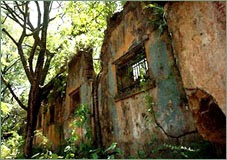

























































8 Comments:
Seriously love this post! So much that I tweeted it and shared it on FB. Thanks! :)
Back in my day we used type writers, not new fangeled computers to do our typin.
The problem with "QWERTY slows you down to help the typewriter" is that... it doesn't slow typists down.
There appears to be no decent evidence that there is any keyboard layout that is significantly better for fast typing.
(This is not because the QWERTY layout is especially good, but because speed is far, far more dependent on training than on the keyboard layout.
You'd have to deliberately design a layout to be slow to get much slowdown, given an identical amount of typing training between test subjects.)
There is in fact a keyboard layout that enables significantly faster speeds - the stenography keyboard:
http://s228.photobucket.com/albums/ee107/jadekf/?action=view¤t=Good_Keyboard.jpg
It's a lot more specialised (and takes a hell of a lot longer to learn to operate) than the QWERTY layout; but the standard operating speed is 250wpm.
It's the machine used for realtime court reporting and most live captioning.
Please note that QWERTY has been possibly designed that way to help sale the typewriters.
When you type TYPEWRITER, you use only the top row of letters, and that was supposedly helping salesmen to sell them: "Look, let's type something! Let's type TYPEWRITER! See, how fast and easy it is?" - could be a very commonly used phrase by tradesmen.
Actually, the QWERTY layout was designed, or intended, to put consecutively typed characters far apart on the little levers, so they wouldn't whack into one another. Anyone who has ever used a mechanical typewriter knows that can happen.
"""
...otherwise users would type faster than the machine could handle, thus jamming the keys. So QWERTY was created to keep that from happening: to keep the machine happy....
"""
Alright, let's assume this argument is true. The conclusion, "...at the cost of typist efficiency." is still wrong... It is WAY more efficient to type slowly and carefully than it is to have to stop and un-jam the keys every few seconds.
Your post is incredible, can’t wait for more updates
Post a Comment
<< Home